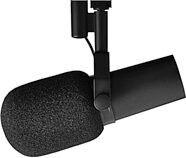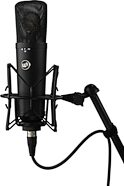Joemeek sixQ2 Microphone Preamplifier and Optical Compressor
No longer available at zZounds


Shape your sound with a single-rack-space channel strip. The Joemeek sixQ2 preamp gives you an optical compressor, three-band Meequalizer, and digital output.
Overview
The Joemeek sixQ2 microphone preamplifier and optical compressor packs a wealth of features into a single rack space studio channel.
Based on the original sixQ, the sixQ2 adds a host of updated features. The microphone input transformer is permanently assigned to the "Mic" Input. The "IRON" switch now optionally sends the "Line" input through the transformer, to add some coloration to Line sources.
The input "GAIN" control now operates over the range 18 dB to 60 dB, with improved resolution in the crucial 25 dB-45 dB range. Microphone inputs up to +4 dBu can be accommodated without distortion (+24 dBu by using the "PAD" switch).
As before, with the "LINE" input selected the gain is unity (0dB) at the top of the dial; the gain range is now -19 dB to +22 dB.
The "Instrument" input now has a gain range of 0 dB to +40 dB.
"PEAK" LEDs now light at +16 dBu (2 dB below Full Scale Digital).
A single channel mic pre, three bands of highly musical EQ, and their signature optical compressor make for a highly capable recording instrument. With a front panel instrument input
Output either analog or digitally directly to your sound card or DAW for a warm, musical analog sound - just what you've been looking for!
The Joemeek Digital Interface has highly stable onboard master clocks for low-jitter, hi-fi results. Internal sample rates of 44.1 kHz, 48 kHz, 88.2 kHz or 96 kHz are selected by means of rear panel switches. 44.1 kHz is the standard used for audio CD's, while 48 kHz and 96 kHz are widely used in recording studios. In general, the higher the sample rate, the better the audio fidelity, but the more disk space is required for the recording. For example, recording at 96 kHz requires twice as much storage as 48 kHz. Consult the manual of your recorder or DAW as to what sample rates it will accommodate. read less
Based on the original sixQ, the sixQ2 adds a host of updated features. The microphone input transformer is permanently assigned to the "Mic" Input. The "IRON" switch now optionally sends the "Line" input through the transformer, to add some coloration to Line sources.
The input "GAIN" control now operates over the range 18 dB to 60 dB, with improved resolution in the crucial 25 dB-45 dB range. Microphone inputs up to +4 dBu can be accommodated without distortion (+24 dBu by using the "PAD" switch).
As before, with the "LINE" input selected the gain is unity (0dB) at the top of the dial; the gain range is now -19 dB to +22 dB.
The "Instrument" input now has a gain range of 0 dB to +40 dB.
"PEAK" LEDs now light at +16 dBu (2 dB below Full Scale Digital).
A single channel mic pre, three bands of highly musical EQ, and their signature optical compressor make for a highly capable recording instrument. With a front panel instrument input
Output either analog or digitally directly to your sound card or DAW for a warm, musical analog sound - just what you've been looking for!
Digital interface
The Joemeek Digital Audio Interface provides high quality digital audio outputs. The digital audio outputs are compatible with most digital recorders, as well as digital audio workstations and mixers. S/PDIF format is available from the RCA phono… read more connectors.The Joemeek Digital Interface has highly stable onboard master clocks for low-jitter, hi-fi results. Internal sample rates of 44.1 kHz, 48 kHz, 88.2 kHz or 96 kHz are selected by means of rear panel switches. 44.1 kHz is the standard used for audio CD's, while 48 kHz and 96 kHz are widely used in recording studios. In general, the higher the sample rate, the better the audio fidelity, but the more disk space is required for the recording. For example, recording at 96 kHz requires twice as much storage as 48 kHz. Consult the manual of your recorder or DAW as to what sample rates it will accommodate. read less
Specs
- Input impedances: Mic: 1.2 kohm; Line: 10 kohm
- Pre-amp overall gain: -2 dB to 60 dB (variable)
- Common mode rejection: 70 dB
- Equivalent input noise: -128.5 dBu (unweighted)
- Distortion: 0.001% (below Compressor threshold)
- Frequency response: 10 Hz to 70 kHz (-3 dB)
- Maximum input before clipping: Mic: +24 dBu; Line: +45 dBu
- Headroom before clipping: +29 dBu
- Compressor threshold: -6 dBu to +22 dBu (variable)
- Compressor ratio: 1:1 to 10:1 (variable)
- Compressor attack time: 1 msec to 100 msec (adaptive)
- Compressor release time: 0.1 sec to 3 sec (adaptive)
- Nominal output levels: +4 dBu/-10 dBv
- Output impedance: 75 ohm
- Output Level switch: 12 dB attenuation
- Noise Floor: -85 dBu (typical, with ~40 dB mic gain)
- VU Meter: Analogue movement
- Power supply: 115V / 230V ac mains, 50/60Hz
- Power consumption: 30W
- Mechanical: 482W x 88H x 220D (overall)
- Weight: 3 kilos
- High Pass Filter: 12 dB per octave cut below 80 Hz
- EQ Boost & Cut: +/-15 dB (zero phase-shift bell response)
- LF Frequency: 40 Hz to 650 Hz variable
- Mid Frequency: 300 Hz to 5 kHz variable
- HF Frequency: 6 kHz/12 kHz switchable
- EQ "Q" 0.9 (1.6 octaves)
- Resolution: 24-bit delta sigma using Wolfson WM8738 ADC
- Sampling Rate: 44.1 kHz, 48 kHz, 88.2 kHz or 96 kHz selectable
- Output Formats: S/PDIF electrical, S/PDIF Optical
- Oversampling:
- This is [sample frequency divided by twice the bandwidth]. So for a 20 kHz bandwidth sampled at 96kHz, oversampling = 2.4x.
- However the term oversampling is sometimes confused with [clock frequency divided by sample rate]. In the DB-1 that would be 256x at 96 kHz
- Noise Floor: typically 92dB A-weighted (referenced to 0dBFS = +18 dBu). So for a +4 dBu signal, the SNR is 78 dB
- Distortion: typically 0.01% @ 0 dBu (20 Hz - 20 kHz) at 96 kHz sample rate
- typically 0.02% @ 0 dBu (20 Hz - 20 kHz) at 48kHz sample rate
- typically 0.02% @ -1 dBFS (20Hz - 20kHz) at all sample rates
- Crosstalk: typically -67 dB (20 Hz - 20 kHz)
- Pre-amp overall gain: -2 dB to 60 dB (variable)
- Common mode rejection: 70 dB
- Equivalent input noise: -128.5 dBu (unweighted)
- Distortion: 0.001% (below Compressor threshold)
- Frequency response: 10 Hz to 70 kHz (-3 dB)
- Maximum input before clipping: Mic: +24 dBu; Line: +45 dBu
- Headroom before clipping: +29 dBu
- Compressor threshold: -6 dBu to +22 dBu (variable)
- Compressor ratio: 1:1 to 10:1 (variable)
- Compressor attack time: 1 msec to 100 msec (adaptive)
- Compressor release time: 0.1 sec to 3 sec (adaptive)
- Nominal output levels: +4 dBu/-10 dBv
- Output impedance: 75 ohm
- Output Level switch: 12 dB attenuation
- Noise Floor: -85 dBu (typical, with ~40 dB mic gain)
- VU Meter: Analogue movement
- Power supply: 115V / 230V ac mains, 50/60Hz
- Power consumption: 30W
- Mechanical: 482W x 88H x 220D (overall)
- Weight: 3 kilos
- High Pass Filter: 12 dB per octave cut below 80 Hz
- EQ Boost & Cut: +/-15 dB (zero phase-shift bell response)
- LF Frequency: 40 Hz to 650 Hz variable
- Mid Frequency: 300 Hz to 5 kHz variable
- HF Frequency: 6 kHz/12 kHz switchable
- EQ "Q" 0.9 (1.6 octaves)
Digital output specifications
- Sampling: 24 Bit- Resolution: 24-bit delta sigma using Wolfson WM8738 ADC
- Sampling Rate: 44.1 kHz, 48 kHz, 88.2 kHz or 96 kHz selectable
- Output Formats: S/PDIF electrical, S/PDIF Optical
- Oversampling:
- This is [sample frequency divided by twice the bandwidth]. So for a 20 kHz bandwidth sampled at 96kHz, oversampling = 2.4x.
- However the term oversampling is sometimes confused with [clock frequency divided by sample rate]. In the DB-1 that would be 256x at 96 kHz
- Noise Floor: typically 92dB A-weighted (referenced to 0dBFS = +18 dBu). So for a +4 dBu signal, the SNR is 78 dB
- Distortion: typically 0.01% @ 0 dBu (20 Hz - 20 kHz) at 96 kHz sample rate
- typically 0.02% @ 0 dBu (20 Hz - 20 kHz) at 48kHz sample rate
- typically 0.02% @ -1 dBFS (20Hz - 20kHz) at all sample rates
- Crosstalk: typically -67 dB (20 Hz - 20 kHz)
No longer available at zZounds
In most cases, a product is unavailable because it has been discontinued by the manufacturer
This is a carousel with product cards. Use the previous and next buttons to navigate.












